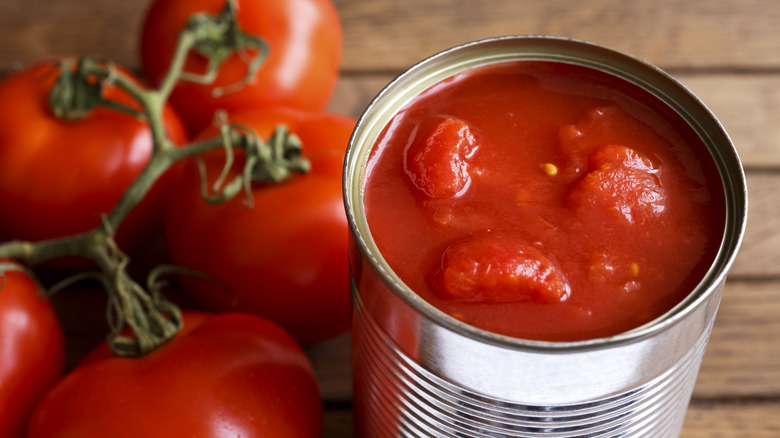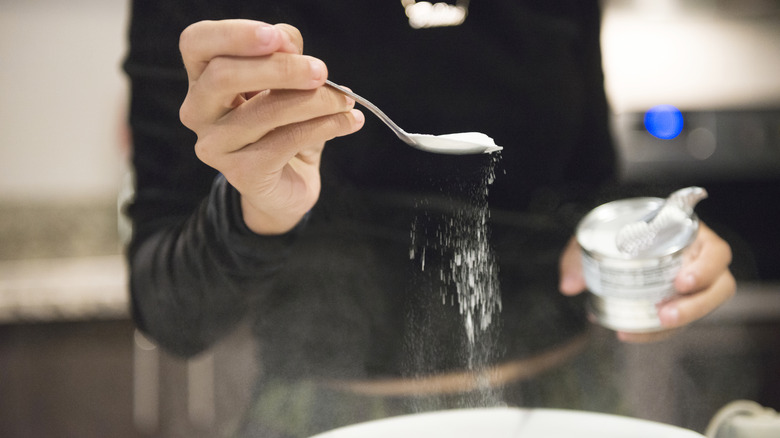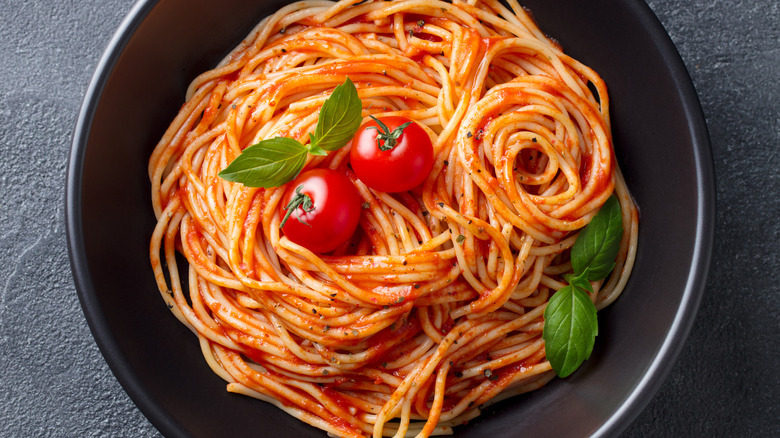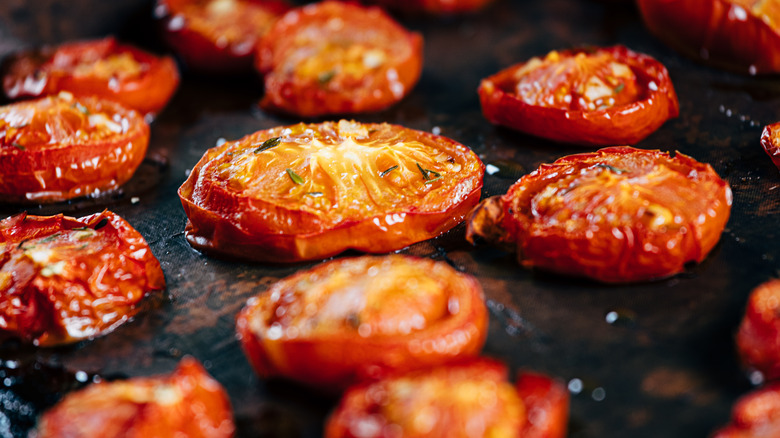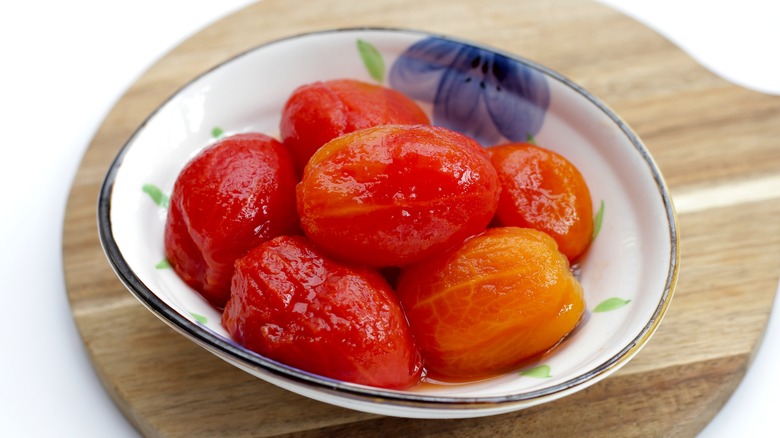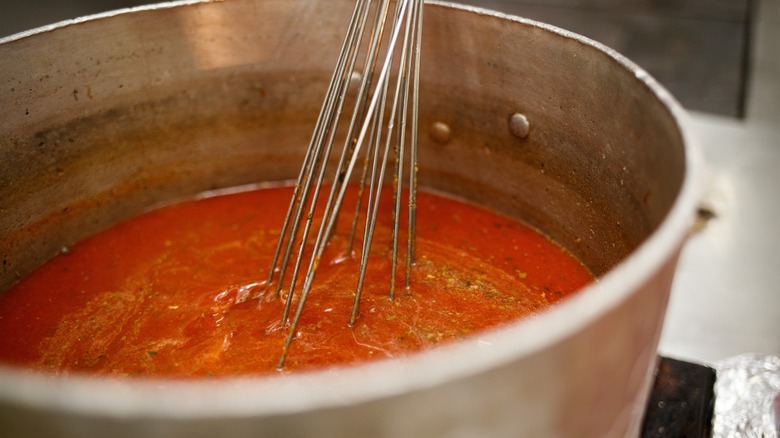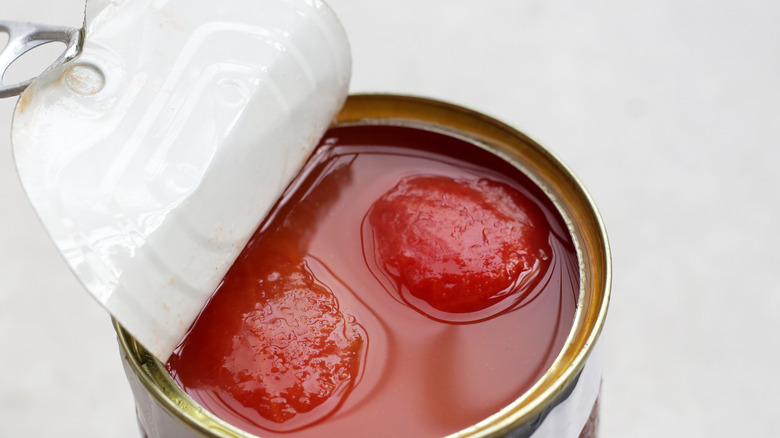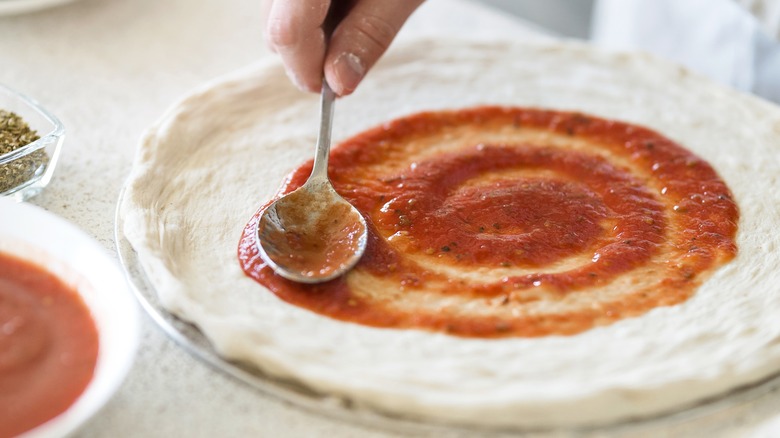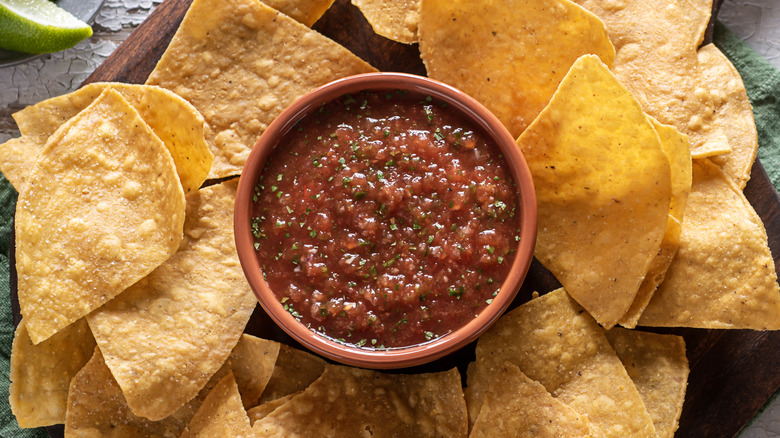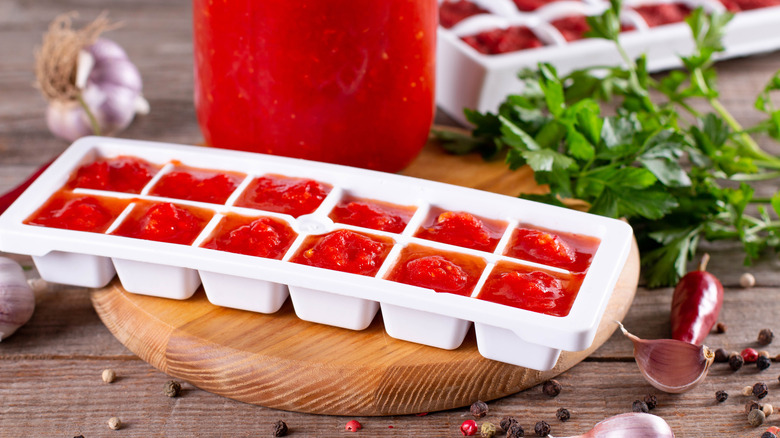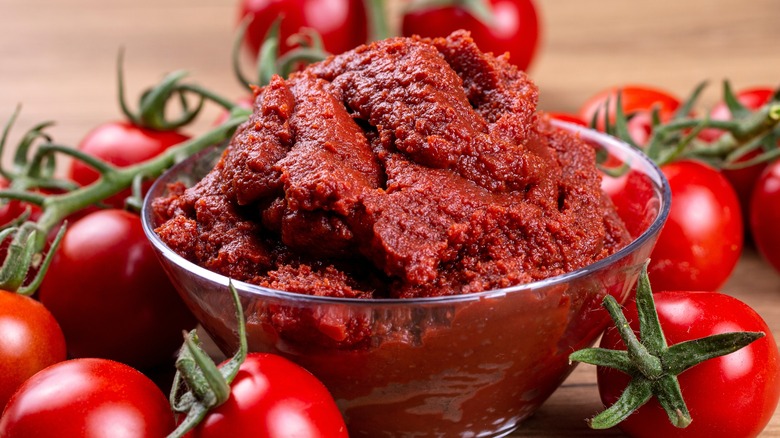13 Canned Tomato Hacks You'll Wish You Knew Sooner
Canned tomatoes are a pantry staple that home cooks should have on hand at all times. Versatile and generally inexpensive, they're perfect to use in a wide range of recipes in a pinch. For those fresh produce purists out there, canned tomatoes are often more flavorful than their fresh counterparts. Picked at peak ripeness, canned varieties are a good option in the winter and spring when tomatoes are out of season.
Tomatoes are a great source of vitamin C, potassium, and folate, making them a healthy addition to any meal no matter how you eat them. While you might assume that canned tomatoes are less rich in nutrients than fresh ones, they actually contain more lycopene. This antioxidant is responsible for the fruit's bright red color and thought to protect against environmental toxins and even some cancers.
Canned tomatoes come in many shapes and sizes 一 you have your choice of whole, crushed, diced, and stewed, as well as tomato sauce, puree, and paste. With so many options, it's difficult to know which ones are best for your recipe. Luckily, we've put together a list of ways to make the most of your cans, going beyond just plain old pasta sauce. These creative hacks may transform the way you cook with canned tomatoes.
1. Add a pinch of sugar
Perhaps the biggest problem with canned tomatoes is the bitterness. You know the taste: a sharp, metallic flavor that persists even after seasoning your sauce with spices. The acidity of the tomatoes and preservatives is typically the culprit here. Thankfully, there's one simple trick to counteract this unpleasant aspect. A pinch of sugar can balance out the bitterness and improve the taste of tomatoes that aren't naturally sweet enough.
While you may balk at the thought of putting sugar in your spaghetti, just remember that many bottled tomato sauces contain high levels of sugar. By making your sauce from scratch, you can control the amount of sugar you add. Many recipes recommend adding sugar near the end since the cooking process itself can release natural sweetness from the tomatoes. Give them first a chance to work their magic, and if the sauce is still bitter, add small pinches of sugar at a time. Be careful not to oversweeten your sauce or it can quickly veer into ketchup territory.
2. Add baking soda to lower the acidity
If you're dealing with overly acidic canned tomatoes, sometimes sugar just isn't the answer. While it works well in some pasta sauces, not every recipe benefits from the added sweetness. Another trick to balance out the bitterness is to add a touch of baking soda. Common advice is to add ¼ teaspoon at a time to your tomato-based sauce as it's cooking. Or, you can start with a pinch and sprinkle in more as needed, tasting your food as you go to avoid overdoing it.
Expect to see some fizzing as the baking soda reacts with the acid in the tomatoes. This means it's working 一 the baking soda raises the pH of the tomatoes, resulting in a less acidic dish. Make sure not to go overboard with the baking soda, however. Too much can alter the flavor profile and ruin your recipe. Also, if you're watching your sodium intake, adding baking soda will increase the sodium levels in your dish.
3. Toss in a carrot for sweetness
If you're not keen on trying out the baking soda method, or if you're looking to introduce sweetness without the added sugar, this method to balance out the acidity in canned tomatoes is for you. Carrots are naturally sweet and can help round out the flavors of your sauce, soup, or other tomato-based recipes.
Giada De Laurentiis, chef and host of Food Network's "Giada at Home," adds a carrot to her simple tomato sauce recipe. She recommends chopping it up and sauteeing it with onion, garlic, and celery until the veggies are soft. Then, add canned crushed tomatoes, bay leaves, and basil and let it all simmer for about an hour. To achieve a smooth finish, put everything into a food processor. And that's it! This method avoids any additives that could potentially throw off your recipe, while still ensuring a perfectly smooth texture and taste. You won't even miss the sugar.
4. Roast whole tomatoes with spices
There's nothing like biting into a sweet roasted tomato that's bursting with flavor and freshness. They go well with everything, from pasta and salads to sandwiches and toast. Thankfully, you don't have to wait for peak tomato season. While it might seem strange, you can actually roast tomatoes from the can. The trick is to use whole tomatoes. The least processed of the bunch, whole canned tomatoes are your best bet for a bold, fresh tomato flavor.
After draining them, cut the tomatoes in half and remove the seeds, then place them in a pan. From there, you have free rein over your toppings. After drizzling on the olive oil, feel free to get creative with the herbs and spices as you would with fresh tomatoes. In addition to salt and pepper, other delicious options include garlic, rosemary, thyme, red pepper flakes, and smoked paprika. Roast the tomatoes in the oven at 300 F for up to two and a half hours. This simple trick will hold you over until summer when the farmer's markets are teeming with juicy red tomatoes.
5. Strain the tomatoes first
You may be tempted to open a can of tomatoes and dump the entire contents into a sauce or soup. But if the end goal is a thick consistency, there's one trick that can help you out. Straining your tomatoes before you add them to the pot can result in a less watery texture. Be sure to save the juice in a bowl in case you need to add more liquid later to adjust the consistency.
Another benefit of straining your tomatoes is that it improves the taste. By removing the seeds, you'll also reduce the bitterness they contribute. Pour the can into a bowl, cut off the stems, and squeeze the tomatoes with your hands. The seeds should fall back into the bowl with the tomato juice. Set aside the squeezed tomatoes, then pour the bowl with the juice through a fine mesh strainer to catch all the seeds. You can add the seedless juice back into the tomatoes if desired. You should end up with tomatoes that are more flavorful and less bitter. Plus, seed-free tomatoes will make your sauce or soup even smoother.
6. Use whole or crushed tomatoes for smoother sauces
It can be overwhelming trying to choose between all the different types of canned tomatoes. You may be tempted to pick up a can of diced tomatoes to save some time on chopping. However, if you're making pasta sauce, tomato soup, or any other recipe that calls for a smooth texture, you'll want to use whole or crushed tomatoes.
Diced tomatoes take longer to break down when cooking thanks to calcium chloride, a compound added to the can to help the chunks retain their shape. This means you likely won't end up with a smooth consistency, no matter how long you stir the pot. Instead, opt for whole or crushed tomatoes that are less processed and break down nicely when cooked. Always make sure to check the label though, as some brands add calcium chloride to all their varieties, even the whole tomatoes.
Far from useless, diced tomatoes still have their place in the kitchen. For example, they come in handy when making more textured recipes such as stew or chili. Since they hold their shape so well, you'll still find discernible chunks of tomato when it comes time to eat.
7. Chop whole tomatoes directly in the can
It's no secret that whole canned tomatoes tend to pack more flavor than their processed counterparts. However, it can be a hassle to prep whole tomatoes when it's so easy to just buy chopped or crushed ones instead. When opting for whole tomatoes, most people likely remove them from the can and chop them on a cutting board. But this takes time (and adds to the pile of dishes to wash).
Luckily, there's one easy trick to quickly break up whole tomatoes, no cutting board required. After opening your can, take a pair of clean kitchen shears and dip them directly into the tomatoes. With this method, you can cut them into your preferred size before they even leave the can. This simple step barely adds to your cooking time but can have a big impact on the final flavor.
If you want noticeable chunks of tomato in your recipe but still want to use whole tomatoes, set aside some pieces and add them when you're further along in your cooking. This way, you'll still get some texture without having to use tomatoes processed with calcium chloride.
8. Use canned tomatoes as a base for pizza sauce
Pizza sauce comes in many forms at the store, including cans, jars, and squeeze bottles. However, many pre-made sauces are packed with sugar, sodium, preservatives, and who knows what else. Plus, they rarely taste as good as homemade versions. Fortunately, it's not too difficult or time-consuming to whip up a pizza sauce using canned tomatoes. In fact, you might already have all the ingredients in your pantry.
Mashed recipe developer Kristen Carli uses canned tomato sauce, tomato paste, Italian seasoning, salt, and pepper in her easy pizza sauce recipe. You can also add cayenne pepper and red chili flakes for an extra kick of flavor. Canned tomato sauce consists of tomatoes that have been cooked and blended to a smooth consistency. Alternatively, you can make your own by cooking down whole or crushed tomatoes.
To make the pizza sauce, throw everything into a saucepan and bring it to a boil. Then, simmer it on low for 10 minutes, and there you have it. This simple sauce is sure to impress on your next pizza night.
9. Throw together a quick salsa
Salsa is the perfect topping or dip for any number of foods. But before you reach for that dubious jar that's been sitting at the back of your fridge, know that making salsa from scratch is as easy as pressing a button on your food processor (plus a few other steps). While you may consider it heresy to use anything but fresh ingredients, consider using canned tomatoes in a pinch. Of course, chunky salsas like pico de gallo require fresh tomatoes, but many restaurant-style salsa recipes call for canned ones.
Tasting Table's fire-roasted salsa recipe mixes fresh jalapeños, onion, garlic, cilantro, and limes with canned tomatoes. Make sure to use fire-roasted diced tomatoes for extra flavor. Chop up the fresh ingredients, zest and juice the limes, and drain the tomatoes. Then, put everything into a blender or food processor. Pulse 10 to 15 times for a chunkier texture or blend it on high for a smoother salsa. After chilling in the fridge for an hour, this salsa is ready to enjoy with tortilla chips or your favorite pairing.
10. Freeze leftover tomatoes for later
We've all been there 一 you crack open a huge can of tomatoes for a recipe and end up with leftovers. Unless you're doubling or tripling your recipe, you probably won't make it through an entire 28-ounce can. So what do you do with the rest? While you can resort to plastic wrap or Tupperware, you'll only have a few days to use them before the mold sets in.
One solution is to freeze them. Simply portion your tomatoes into freezer bags and seal them without any air. They should last up to six months in the freezer; label the bags with dates to keep track. This trick works with any type of canned tomato, even sauces. Thaw the bags on the counter or in the microwave to have tomatoes on hand whenever you need them.
You can also stick your leftovers in an ice cube tray. This method works best with sauces or with crushed, diced, or pureed tomatoes. Just spoon the tomatoes into a tray and wait for them to freeze. While you can use them as needed from the container (flexible silicone trays are a lifesaver here), you can also remove the cubes once frozen and transfer them into a freezer bag to save space.
11. Freeze tomato paste in bags
You may have seen the viral videos of home chefs showing off creative ways to store tomato paste. They all tackle the same common dilemma: What do you do with the rest of the can? Most recipes only call for a very small amount of paste, leaving you with a half-empty can to store. You might opt to pour some olive oil on top of the remaining paste, stick it in the fridge, and hope it doesn't spoil before you need it again. Sure, you can buy tomato paste in resealable tubes and keep it in your fridge, but even those have limited shelf lives (plus they cost more). For many, the solution is to store tomato paste in the freezer.
TikToker Rebeca Huffman shared her clever trick for freezing tomato paste in snack-sized Ziploc bags. After filling, sealing, and flattening the bags, she uses the dull side of a knife to gently score them, dividing the paste into individual portions. The bags then head to the freezer, ready to be snapped off whenever a recipe calls for tomato paste. Other methods include placing portions of tomato paste on or between sheets of parchment paper and freezing it this way.
12. Save the leftover juice for other recipes
If you end up draining your canned tomatoes for a recipe, hold onto that delicious leftover juice. Instead of pouring it down the drain, use it to elevate any number of dishes. Enrich the flavor of soups, sauces, rice, quinoa, couscous, and other grains with tomato juice. Make a tangy salad dressing, or add it to the pot when cooking pasta to bring out a richer tomato taste. Leftover juice also makes a fantastic base for Mexican or Spanish rice, adding vibrant color and depth to the dish. You can also use it to build a tasty stock for a hearty vegetable stew. The possibilities are truly endless.
If you don't plan on using the juice immediately, you can always freeze it. Like with tomato sauce and puree, you can freeze the juice in ice cube trays. When the inspiration strikes, just toss them into your pot to add a burst of tomato flavor to any recipe.
13. Use the juice to make drinks
If you end up freezing the leftover juice from your canned tomatoes into ice cubes, they will also come in handy for drinks. Add them to your Bloody Marys the next time you whip up a batch. Frozen tomato cubes will only enhance your drink as they melt, unlike regular ice that dilutes it. To make a classic Bloody Mary, pour tomato juice into a glass along with pickle juice, Worcestershire sauce, sriracha, horseradish, and vodka. Add lemon juice, salt, pepper, and your choice of garnishes. Then, add tomato juice ice cubes and enjoy.
To take your cocktail to the next level, try seasoning your tomato juice cubes before you freeze them. Experiment by adding salt and spices like basil, oregano, or chili powder. You can even include olives or pieces of celery for an extra snack when the juice melts. If Blood Marys aren't your thing, you can also make Micheladas or throw the frozen juice into a mocktail or smoothie for a non-alcoholic treat packed with tomato flavor.
